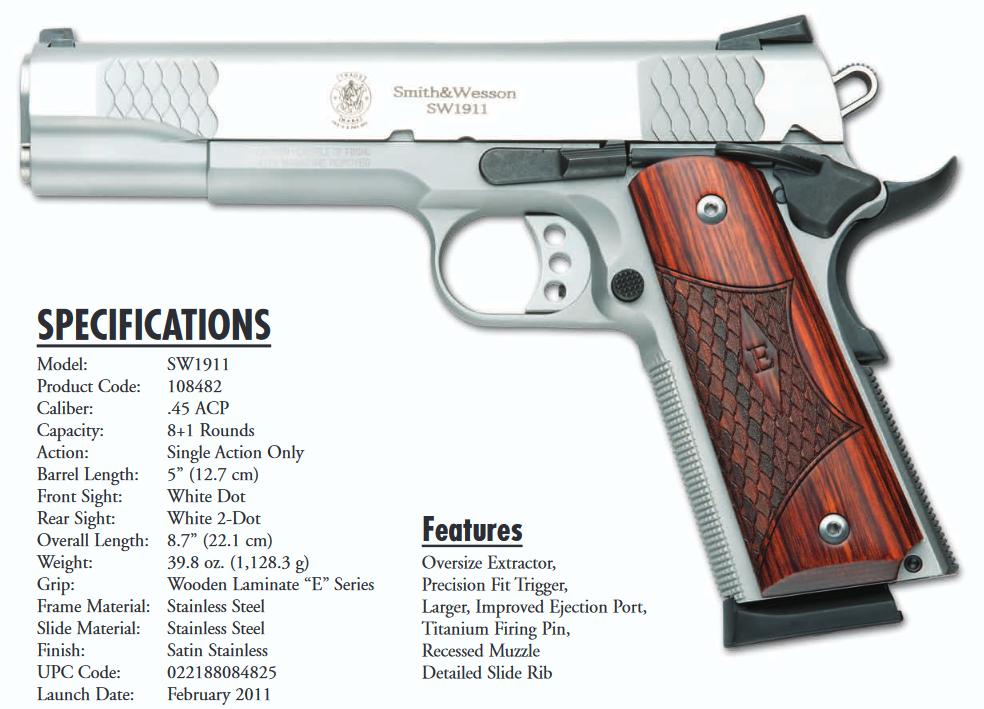
There are any number of reasons that one might change out their Every Day Carry (EDC). A change to something smaller, lighter, and more compact might be one, or even the reverse may be true. Perhaps the firearm you are carrying is showing signs of wear and tear and you need an upgrade. Or, perhaps you have decided to try a different platform. Some of us have carry rotations where firearms are carried for a while and then given a rest while another takes its place until it’s time to rotate again. Some are seasonal rotations, where smaller firearms are carried in the hot weather and then replaced with a more substantial firearm when cold weather hits. That seems to happen often for me, with a bit of a twist. I may evaluate a pistol (or revolver), carry it for a while, and then return to carrying my normal EDC. In my case, I simply needed to upgrade to a better 1911 pistol.
My normal EDC, a Rock Island Armory 1911 FS Tactical was showing wear from daily carry and from being drawn from and inserted into in a ‘Kybrid’ holster many times. The RIA is what I call a 2nd Generation pistol; it had the ‘huge’ billboard on the side of the slide, which I never cared for, and I wanted to change that. The front sight had to be filed down to adjust POI and my refinishing job wasn’t the best. The finish on the slide showed that this was a ‘working’ pistol, and I had been considering getting the slide Cerakoted to spruce it up a bit. The pistol has been an excellent companion, perfectly reliable and accurate enough in my hands, but it was time to relegate it to a less demanding role and not carry it every day. But, what to replace it with?
Even for a person who is somewhat well-versed in the 1911 pistol, the search for a 1911 pistol can be daunting. I read many written reviews and watched many video reviews on Kimbers, Colts, Rock Island Armory, Dan Wesson, Sig Sauer, and other pistols that far exceeded my budget. I still desired a full-size, full-weight, ‘Government’ model 1911 with the usual bells and whistles, but I was not willing to carry a pistol with a high price tag. I also prefer stainless-steel over other materials, since I live and breath in the South where high temperatures and humidity can take it toll on both man and equipment.
Although Smith and Wesson began manufacturing 1911’s in the early 2000’s, it took less than ten years for them to scrap their models and start fresh. In 2011, S&W discontinued all their previous versions but restored their line with an impressive collection of around a dozen variations of the 1911. The SW1911’s are available in either the E-Series or the Performance Center, but even within these two lines, there are several variants.
While I did not pay attention at the time, I have since realized that the “E” Series 1911 pistols from Smith and Wesson are a blend of government model and factory custom pistols, paired with serious stopping power and beautiful aesthetics. The E-Series was updated inside and out, and its appearance is distinct. All-new components have created a state-of-the-art 1911 firearm.
The Smith and Wesson “E” Series 1911 pistol did intrigue me when I first set my eyes on one a long time ago. I was immediately drawn to the sculptured and highly-polished slide. The fit and feel seemed excellent, the front strap checkering was something that you rarely find on a production pistol, and the grip panels were even very nice and a departure from the traditional grip.
My gun club and range recently took in a Smith and Wesson “E” Series 1911 as a range rental along with a Smith and Wesson 9mm “Pro” Series 1911 (a very sweet pistol and, hopefully, a topic for review later) and I took the opportunity to shoot both on several occasions. While I can’t say that the “E” was any more accurate than other range 1911 pistols that I have shot, except for the 9mm Pro 1911, it was a solid pistol and I really took a liking to it.
In all honesty, I was very close to trying to obtain a Kimber Stainless II but was unable to find one. One could be ordered through a Kimber dealer, but I would have to wait until one became available. The Smith and Wesson “E” Series 1911 was beginning to look good. If I ordered one, it would be a two day wait instead of who knows when.
I made a special trip to the range to, once again, try the Smith and Wesson “E” Series out. I took my EDC with me for comparison sake. Comparing the two really cinched the deal and the Smith and Wesson “E” Series, Model 108482 was put on order and paid for.
The Smith and Wesson “E” Series 1911 is to be a ‘precious’ pistol. I had planned to pick it up on my usual Sunday morning BS (breakfast and shooting) session. This would have given me a chance to shoot it before I was to be put in the hospital for heart bypass surgery the following Tuesday. However, the best laid plans sometimes go awry, and I was notified that I was going to be admitted to the hospital the Friday before, and right after some more testing was going to be performed on me. That would mean that I could not pick up the pistol until well after surgery and sometime during or after a full recovery (2 months?). That was just not going to work for me. So, I decided to pick up the pistol before the Friday that I was scheduled to be admitted. That, at least, would allow me to handle and shoot the pistol. After all, there is a slight chance that will not make it through surgery, or through recovery, for that matter, and that would make the Smith and Wesson “E” Series 1911 the last 1911 purchased and fired by me.
Anyway, after the necessary paperwork was completed, the pistol was field stripped, checked, a bore-snake run through the bore, and the pistol was properly lubricated in all the correct 1911 ‘slidey’ and contact places. But, before we go to the range, let’s take a closer look at the pistol for those who are not familiar with it.
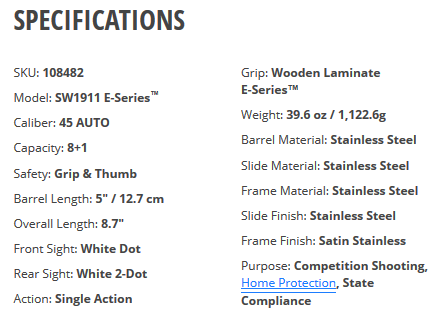
Slip, Sliding Away
One of the first noticeable things about the Smith and Wesson “E” Series 1911 pistols is the slide sculpturing. It is distinct in its design and is what drew me to the pistol in the first place. And, to be honest, I wasn’t sure that I liked it at first.
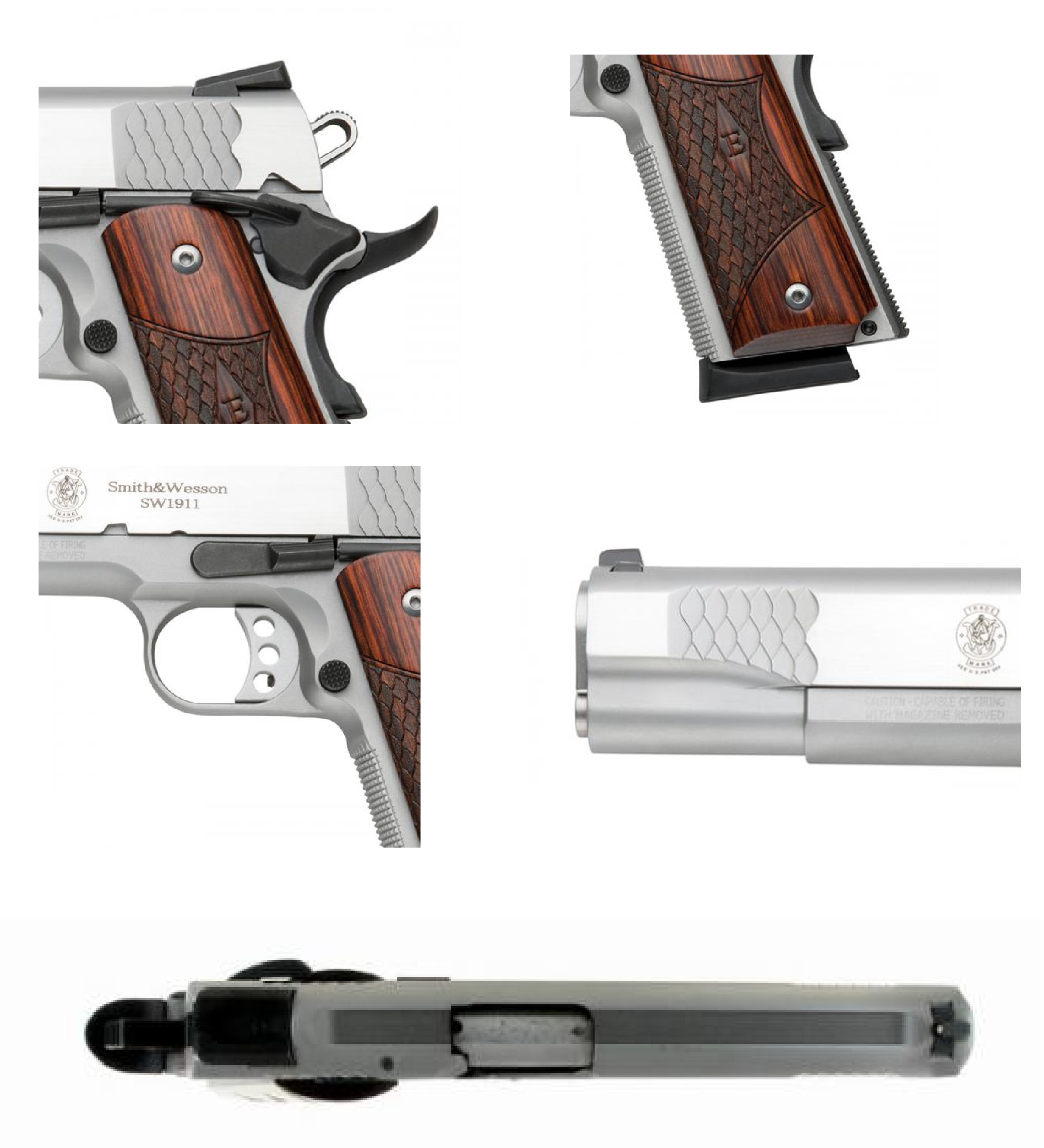
The sculpturing, which some refer to as “fish scales,” are a departure from the usual slanted or vertical serrations that adorn many other 1911 pistol slides. Their design allow the thumb and forefinger of the hand to get a very positive grip on the slide. Forward sculpturing allow press checks for those who prefer it.
The top of the slide is finished like the frame, a satin stainless that helps to reduce glare. Serrations also helps to break up an otherwise solid top. The sides are highly-polished and only interrupted by Smith and Wesson’s laser engraving; Smith& Wesson SW1911 on one side and
The front and rear dot sights are dovetailed for adjusting windage. The rear sight is held in by a set screw, which can be loosened to allow windage adjustments. The sights are low profile, which are excellent for snag-free concealed carry. The sight dots; however, are on the small side, but of course can be changed to something more suitable to the owner’s sight preference.
Looking at the right side of the frame, and if you are accustomed to the seeing the right side of a 1911 pistol, the external extractor is the first thing to be noticed. 1911 purists say that an external extractor has no place on a 1911 pistol. Well, it does in this case. The extractor is too beefy to put on the inside and I have never heard of a Smith and Wesson 1911 extractor needing “tuning” and I have tuned my share of them. Personally, I have no preference but if a change makes extraction better, I am all for it.
The dust cover is of a brushed stainless that blends in quite nicely with the brushed stainless finish of the frame.
The slide to frame fit is tight throughout the slide stroke, and very smooth I might add.
While we rarely pay attention to such things anymore, since they are standard fare on all but original 1911 configurations, is the large and flared ejection port. Along with the beefed-up extractor, spent shells are quickly and fluidly ejected from the pistol.
The firing pin is titanium and is used in conjunction with a heavy firing pin spring. This combination negates the use of a firing pin block, which means there is none. Some refer to this as a “Series 70” 1911 version.
Framing it Out
The satin stainless finish of the stainless-steel frame is excellent. The lines of the frame are blended very well into each other. There is a slight undercutting under the trigger guard that stops abruptly at the 20 Line Per Inch checkering of the front strap. A lot of manufacturers simply provide vertical serrations, if anything at all, on the front straps of production 1911 pistols. Combined with the checking of the main spring housing, there is ample ‘grippiness’ to the pistol. The only thing that I would have like to see at the bottom of the grip is a magazine well extension that would help blend the eight-round bumper-padded magazine with the pistol.
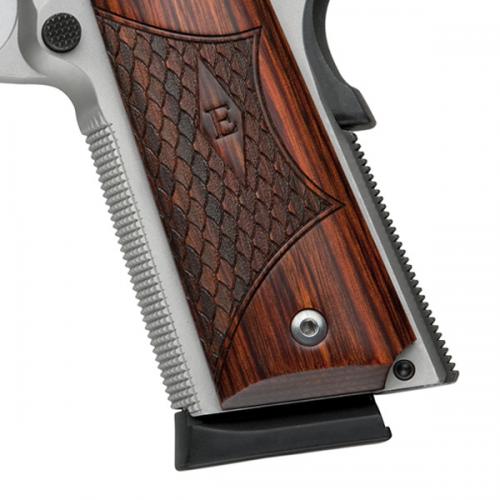
The grip panels are very nicely sculptured wood laminate with a beautiful grain pattern. The grip panel sculpturing is a close match to the slide sculpturing. The sculpturing falls where the fingers of the gripping hand would most likely be and aids in holding on the pistol. Stainless steel hex-head screws secure the panel to the frame via bushings. I have no reason to swap the grip panels with my usual Hogue Rubber Molded Finger Groove grips, but a set of ebony wood grip panels, or very dark composite grip panels, would look great. A set of ‘Silverblack’ grip panels from Altamont (see below) that, I feel, accents the pistol well and provide enough texturing for a good grip.
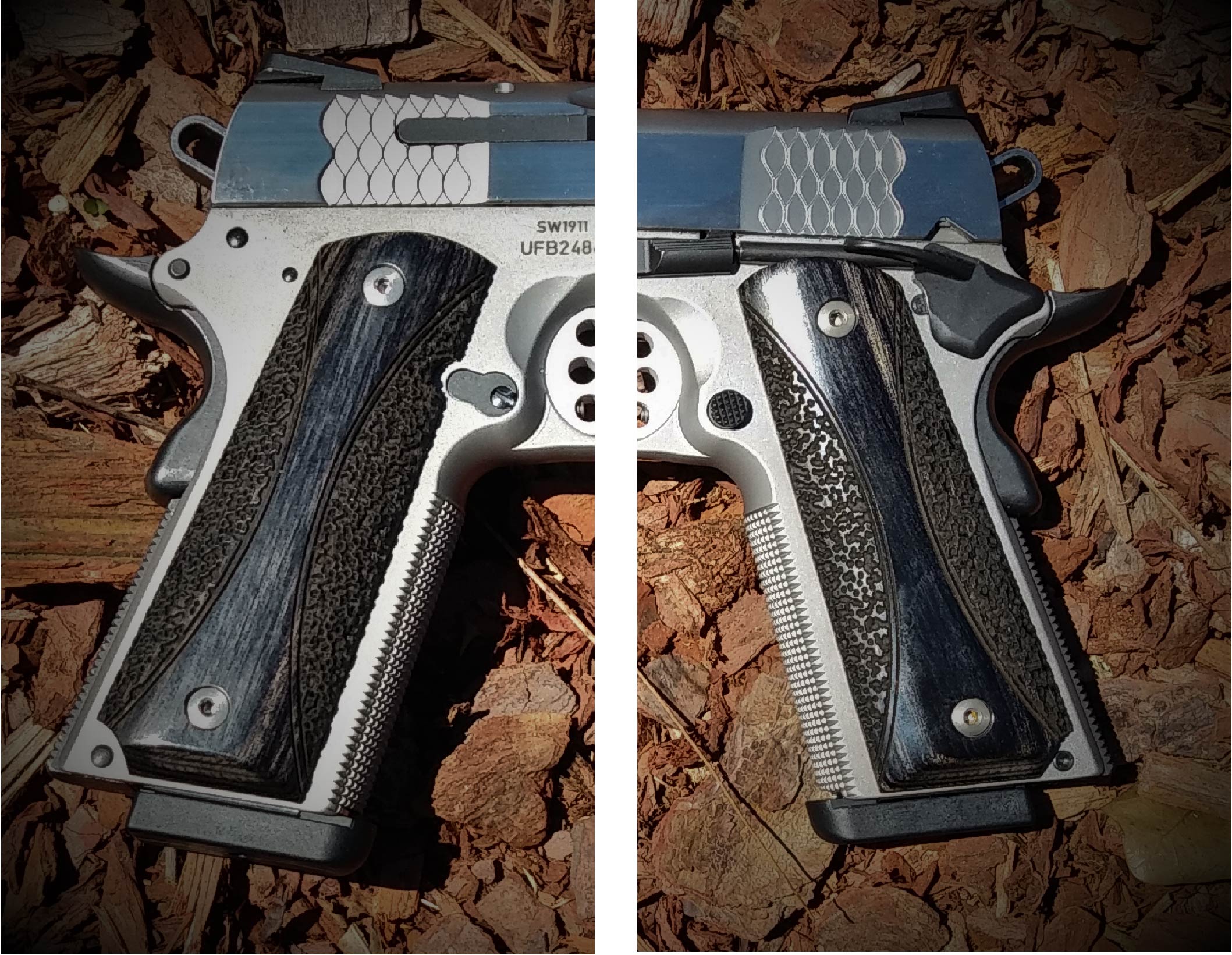
Taking Control
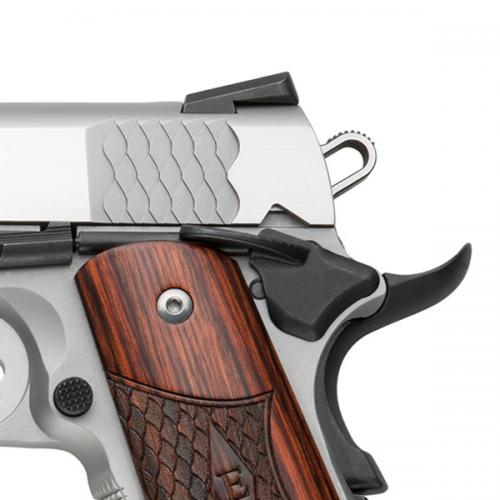
Controls are the usual MIM parts that comprise the slide lock/take-down lever, the grip safety with memory bump, and a left side only thumb safety. The slide lock/take-down lever left side only thumb safety are extended for ease of engagement/disengagement. All are black, which gives a nice contrast to the stainless steel. The safety engagement/disengagement is positive in both directions and is easily operated with the thumb. The bump on the very nice beavertail grip safety ensures those, like me who like to get as high a grip on the pistol as possible while riding the safety lever, that the grip safety will stay in while operating the pistol.
The magazine release button is extended and still only available on the left side of the pistol, as originally intended by John Moses Browning.
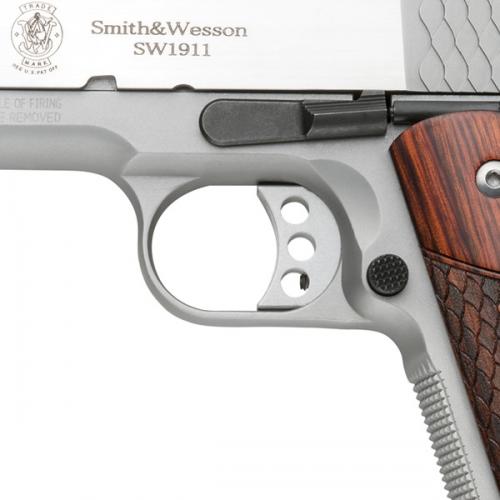
The trigger is excellent, with just a bit of side play. With that said, the side play seems to be under pressure rather than just loose, which means that the trigger yoke is properly fitted within the trigger channel of the frame. That is a good thing. Pull the trigger to the rear and it just rolls through the break with no over-travel. Reset is as quick and positive, as becoming that of a good 1911 trigger.
The long trigger is your now-standard skeletonized type with over-travel screw (not that over-travel adjustment is needed). The hammer is the now-standard skeletonized and roiled “combat” hammer that, when cocked, nestles nicely into the beavertail well.
1911 triggers have always been problematic, but Smith and Wesson may have finally found the solution. The E-Series has a new S&W engineered Joubert trigger, on which I have not been able to find information. The innovative trigger can be individually hand-fitted to the frame during assembly to eliminate any misalignment. Overall, the Joubert system provides a custom-trigger feel without the expensive price tag.
Barrels of Fun
The barrel and slide are well-mated through a standard bushing. The muzzle is recessed, which keeps bad things from happening to good barrels. The barrel, of course, is 5-inches as is standard for a full-size 1911. The twist rate is the standard 1:16 and fully supports the .45 ACP case.
The guide rod is the single-piece full length type that is the point of contention for many. However, there is a cure for all this contention – replace the FLGR with a standard G.I Guide rod and plug of your choice and move on. Problem solved. For me, it is part of the pistol and so it will remain.
The Smith and Wesson 1911 “E” Series disassembles and assembles like any other 1911 and no wrench is needed as with two-piece guide rods, although you will need the usual bushing wrench until the recoil spring breaks in.
The Weight of it All
Weighing in a 39.8 ounces dry, the Smith and Wesson “E” series is not a light pistol to have, to hold, and to carry, but that weight sure helps when you shoot it.
The 1911 pistol just seems to have a natural balance and feel to it, and the Smith and Wesson “E” Series 1911 is no exception.
I have carried a full-size, full-weight 1911 around, and totally concealed, for quite a few years. I have also carried a lightweight “Commander” at times. While for the ‘newbie’ to full-size pistol the weight may be cumbersome, the weight is well worth it when it comes times to put lead on target.
Worth the Weight – Range Time
As was mentioned at the beginning of the article, the Smith and Wesson “E” Series 1911 was field stripped, cleaned and lubed, and otherwise made range-ready. Now it was time to see what this Smith and Wesson “E” Series 1911 would do. I already had a preview, since I had shot a Smith and Wesson “E” Series 1911 previously, but that was not “My” Smith and Wesson “E” Series 1911.
A silhouette target was set at 7-yards distant and it was time to check for function and, hopefully, some determination of relative accuracy.
Accuracy? How Do I Count the Ways?
So, the object here is to hit what I am aiming at. Ammunition notwithstanding, for that to happen, there are a myriad of things that must happen correctly; stance, grip, sight picture, trigger pull, breathing, trigger reset, controlling recoil, etc.
I am used to the 1911 platform so I can’t use that as an excuse. The best that I can tell you is how the pistol performed at a given time in my hands, and I have no doubt that you may be able to do better given enough trigger time with the pistol.
I had fifty rounds of 230-grain FMJ ammunition from Georgia Arms and twenty-five rounds of Sig Sauer 230-grain JHP to begin breaking in the pistol. Both obviously are going to garner different results due to the differences in ammunition. What I am looking for a “Combat” accuracy; what is the pistol capable of doing in my hands shooting off-hand in my normal, modified-Weaver stance? And, how consistently can I make thing happen to determine a degree of precision?
Well, the Smith and Wesson “E” Series 1911 is quite capable of excellent accuracy and precision; at least, combat accuracy. And, it is quite capable of putting multiple rounds in the same hole – if everything comes together.
After I figured out where the pistol was telling me to aim, fifty shots of ball ammunition cleared out the “X” ring, while twenty-five rounds of defensive ammunition (my normal carry load) gave a nice 3-inch average of head shots at 7 yards (I pulled one shot and knew when I did it, but the impact was still in the head). Speed between shots varied between really taking my time and 3 second timed shots. And, it did all of this without failure of any kind right out of the box.
The Final Verdict
Not to use an old cliché that has been used over and over, but the Smith and Wesson “E” Series 1911 is more accurate than I can make it. The Smith and Wesson “E” Series 1911 has now replaced the tried and true Rock Island Armory 1911 FS Tactical as my EDC.
A New Home
I have been working my way back to all leather holsters over ‘Kybrid’ holsters for IWB. My favorite is the Savoy Leather line of holsters. The Smith and Wesson “E” Series 1911 looks great in one with the “Savoy” pattern. The Smith and Wesson “E” Series 1911 looks great in any holster, but a holster has been specifically ordered for “Precious” and that is a Falco A112 Hawk, Stable easy on IWB leather holster.
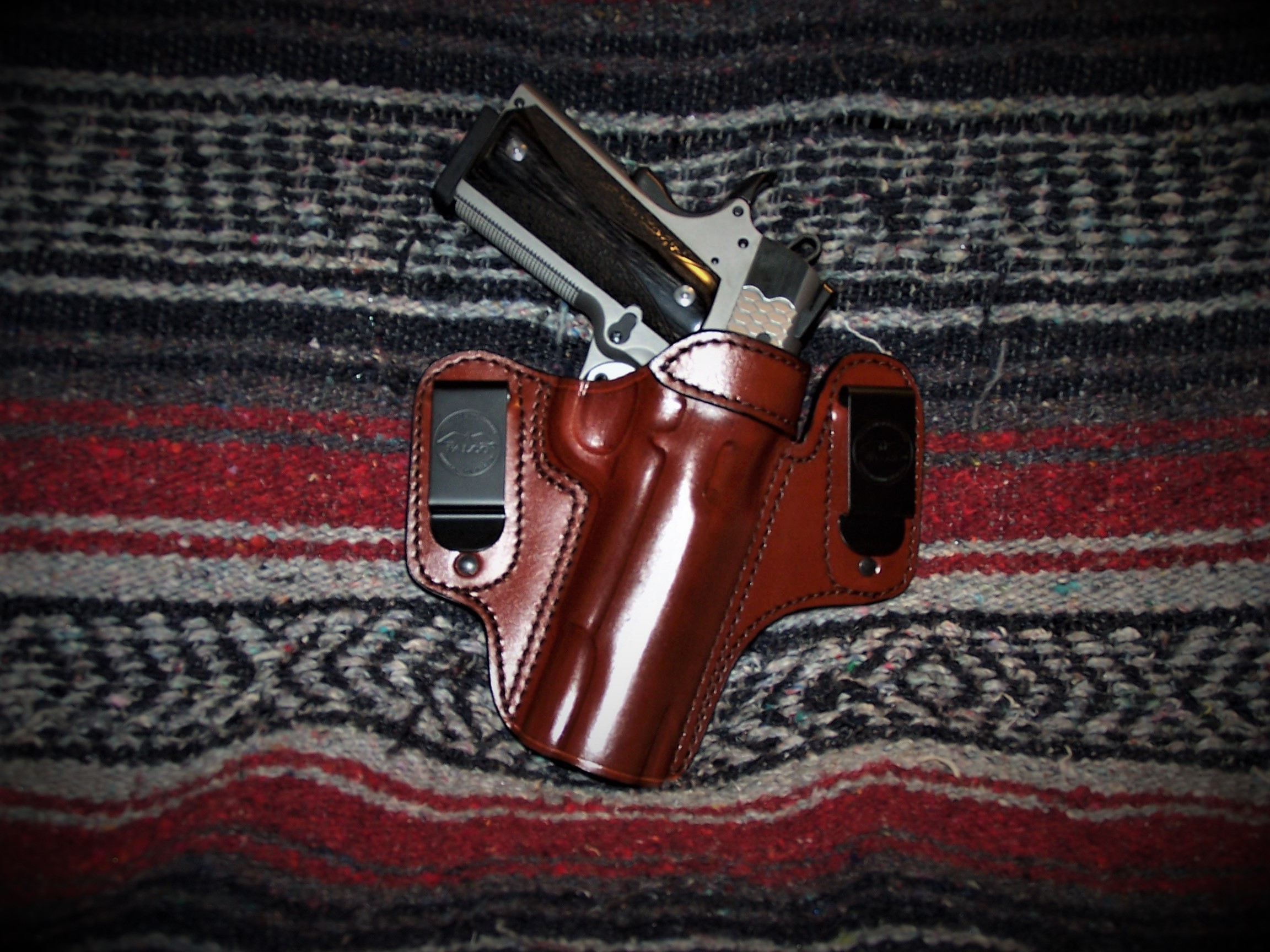
Concealment

Smith and Wesson “E” Series 1911 in a VersaCarry “Comfort” IWB Holster
For those in the colder regions of the U.S. it seems like sixteen months of winter where big jackets and sweatshirts are worn. This allows the carry of just about any caliber CCW. But, when summer rolls around, whether North, South, East, or West, that changes. Carrying a full-size .45 ACP is more difficult to conceal in shorts and a t-shirt.
Carrying a full-size fighting handgun like a “Government” model 1911 takes some serious thought and consideration to dressing around the pistol and some other factors.
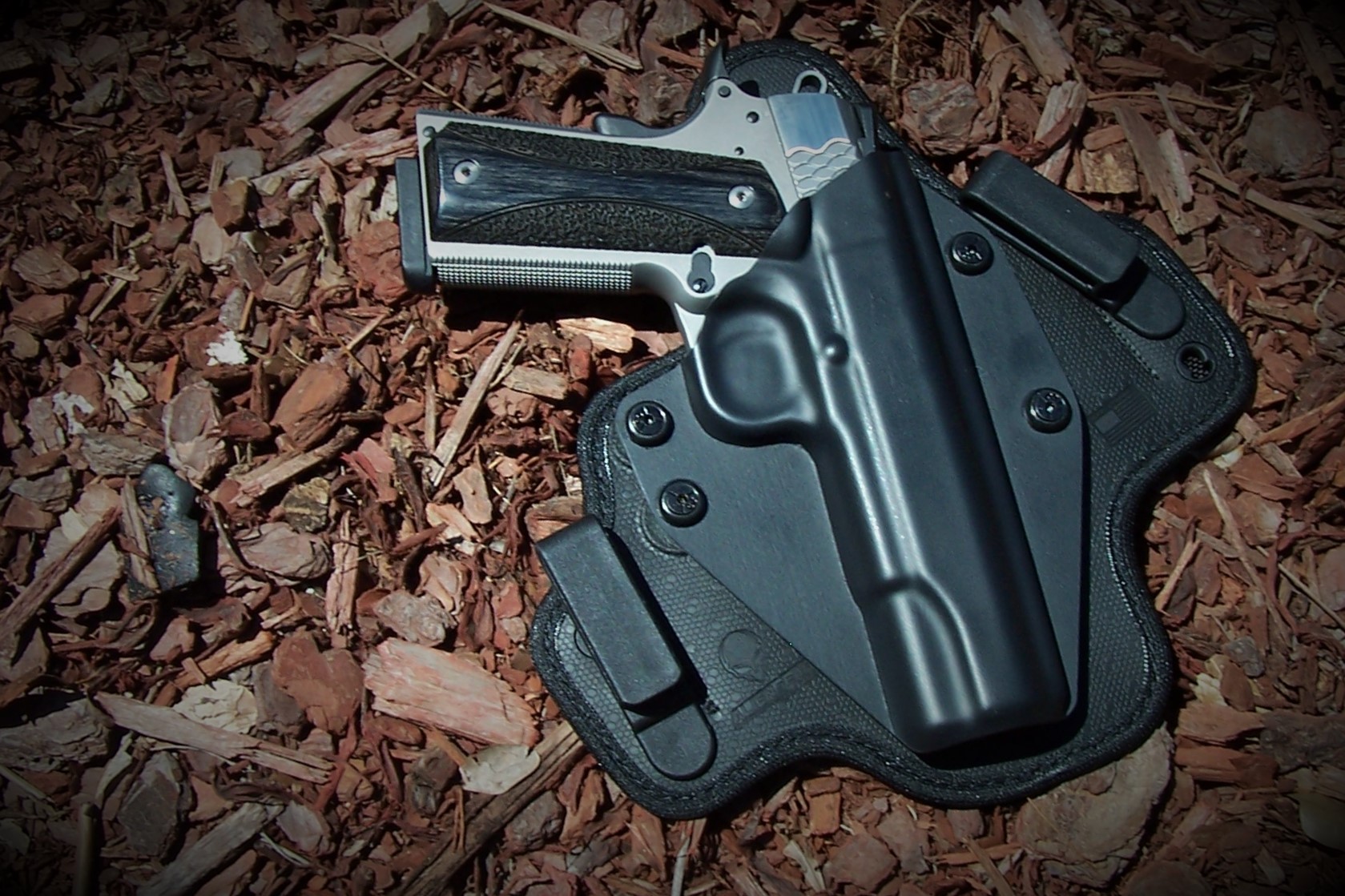
A semi-automatic pistol is difficult to conceal, simply because it is a straight-line object that does not conform to the body’s shape. We have hips and waist, although the waist may be inside the hips or outside the hips – contours matter when carrying a foreign object on the body. A revolver is much more compatible with the shape of the body.
The squared-off butt of the 1911, and a protruding base of the 8-round magazine adds to the complexity of concealing the pistol. Not the target of this review; however, is the SW1911SC E-Series™ Round Butt Scandium Frame, which provides a bit more concealable and lighter pistol – at a much higher price, of course.
The selection of a proper holster cant and depth can go far in effectively concealing a large semi-automatic pistol. An IWB holster where the cant and depth of the holster can be adjusted is ideal regardless of the type of holster; hybrid or otherwise. You may be able to adjust the cant a bit more forward than the typical FBI (15-degree) cant to better conceal the butt of a “Government” or “Commander” 1911 pistol, or any pistol for that matter. The slide or barrel, up to a point, is not the most difficult to conceal.
I have been able to effectively conceal large pistols and revolvers because of my size; whereas, somebody with a smaller body makeup would have difficulty. The bigger you are, the easier it is to hide stuff.
I have seen some FUBAR attempts by other people to conceal a handgun in my time, and I can’t say that I didn’t mistakes in the early days of doing so. But I learned what was best and not what was fashionable.
A full-size 1911 pistol can be effectively shot and concealed, if you do your part.
The Last Word
I discounted the Smith and Wesson “E” Series 1911 at first simply because it was different; however, I have come to learn just how viable a defensive pistol the Smith and Wesson line of 1911 pistols can be. Plus, they just look darn good.
If you are looking for an excellent 1911 for a fair price (MSRP: $979 at the time of this writing), take a step outside of the normal 1911 box and look at the Smith and Wesson “E” Series of 1911 pistols.
Resources
Smith and Wesson “E” Series 1911 Pistols: https://www.smith-wesson.com/firearms/sw1911-e-series


![]()


2 Responses to Smith and Wesson “E” Series 1911